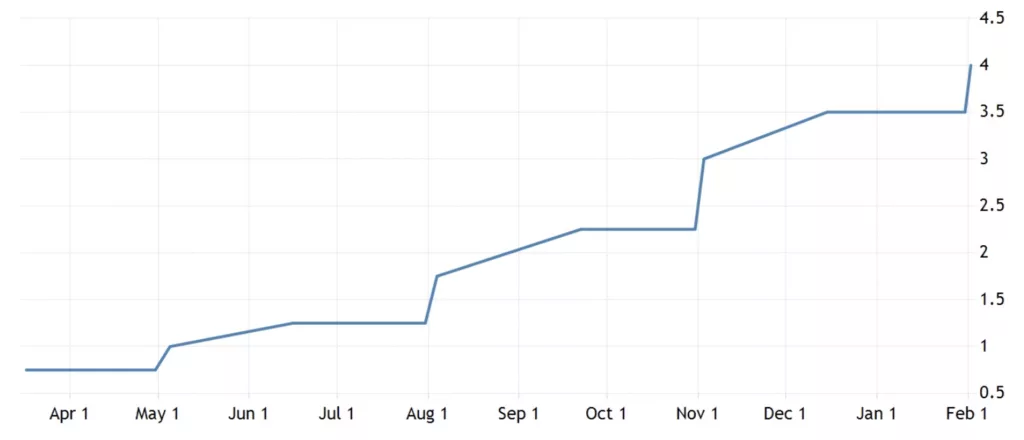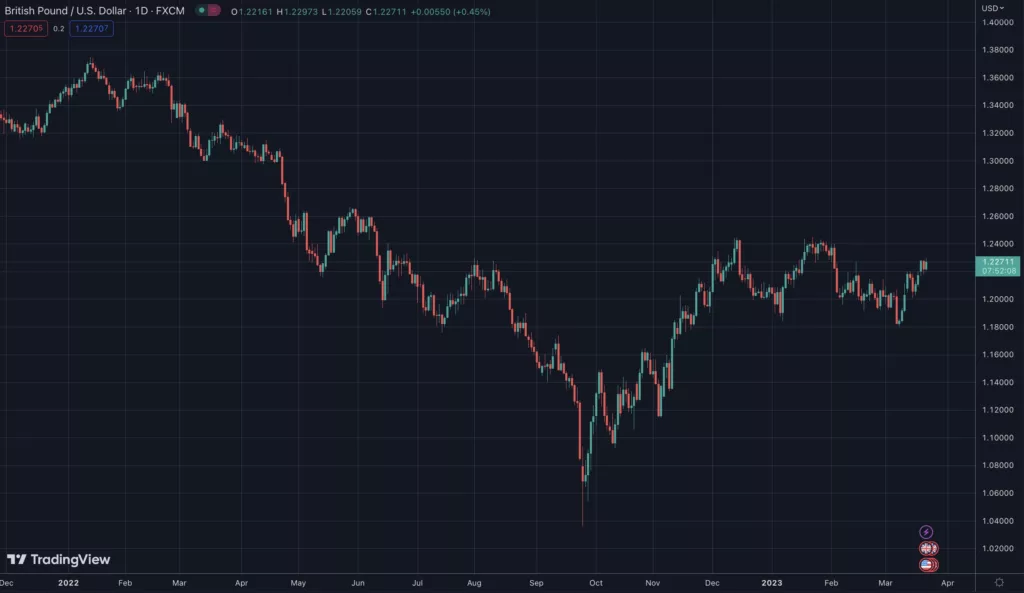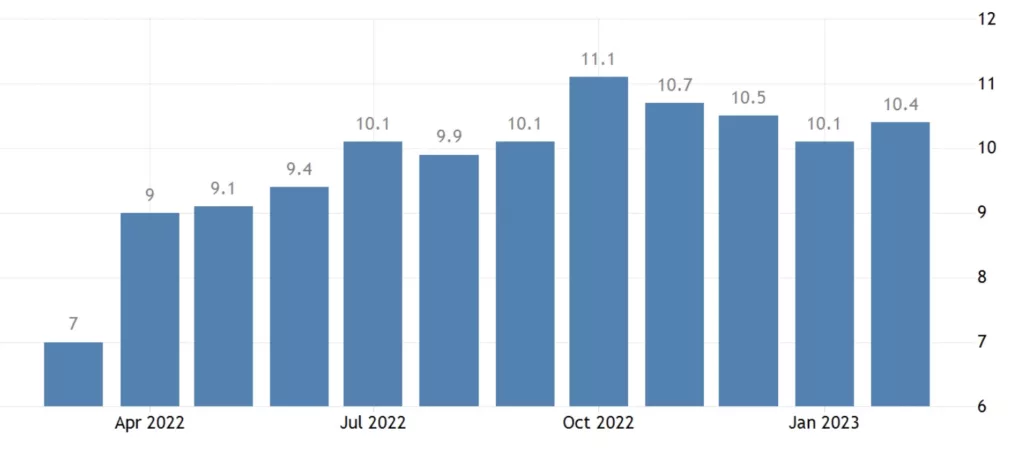The United Kingdom has seen a slightly higher inflation rate year on year in February at 10.4% as opposed to 10.1% in January.
“The largest upward contributions to the monthly change in both CPI rates came from restaurants and cafes, food, and clothing, partially offset by downward contributions from recreational and cultural goods and services (particularly recording media), and motor fuels,” said the Office for National Statistics.
A shortage of salad last month, including tomatoes and other veg, is being blamed for this slight tick, with restaurant prices and alcohol prices in pubs also rising.
This surprise counter-trend echoes the January data in US when inflation came at 6.4%, barely down from 6.5%, worrying some analysts that the downtrend since June might no longer continue.
The February inflation data however came at 6%, easing those worries, although markets still expect a 0.25% hike by the Federal Reserve Banks later today after the decision was leaked, turning a 50/50 bet into 90% betting on hikes in ‘futures’ markets.
Whether this experience will repeat in UK with March showing a significantly lower inflation rate remains to be seen, but here too there has been a downtrend – though far more shallow – with their peak being 11.1% in October.

Just why UK is seeing a considerably higher inflation rate than US and a far slower downtrend is not clear, especially as Fed and the Bank of England have been raising rates in tandem with the Bank of England being only about 50 basis points behind.
They will hike again tomorrow to 4.25% from 4%, but this almost identical experience in interest rates with different inflation results does suggest that interest rates alone are not quite a determinant of inflation.
Another one is of course the value of fiat, both against goods, but most crucially its relative value against other fiat.


As you can see here we have an inverse mirror between the price of the pound against the dollar, and the inflation rate in UK.
That makes sense because a lot is priced in USD, including oil and gas, or salad and tomato.
Yet why did the pound not just fall but crash against the dollar last year from $1.36 to near parity for the first time in history?
A significant part of that is speculators, which the Bank of England did nothing to counteract, but another reason may also be that the M2 money supply in US began to fall sharply in August from $21.7 trillion to $21.2 trillion.
There’s M3 and M4 above that, but US doesn’t release that data, so in an equivalent measure, UK’s M2 barely went from $3.2 trillion – and only in one month in September – to $3.1 trillion. If we discard September, it has stayed still at $3.1 trillion.
The question is again why? If both were moving in tandem on interest rates, why did one’s money supply fall, but not the other’s?
We do not know the answer to that as it is probably something that would require a full on academic study, but this comparative data analysis indicates there is no direct causative correlation between interest rates and either the M2 supply, the value of national fiat, or inflation because there have been two different outcomes when interest rates have basically been the same and have moved in the same way within the same timeframe.
On the other hand, interest rates and the other three have correlated in US, just not in UK. The question however is whether they correlated in US at the expense of others, like UK, or due to more objective criteria, in which case you’d expect them to have correlated in UK too.
Another way of putting it is, had the pound et al not fallen, would US still have a 9% inflation rate? A question to which we don’t have an answer but looking at the A/B data we do have, it may well be in that situation it would have fallen a bit less in US, more in UK, but fall in both.
Instead it has significantly fallen in US and almost none in UK because speculators decided to crash the pound and the Bank of England did nothing about it.
This of course is a very old problem and it used to be called mercantilism when countries used to get an edge by hoarding gold or flooding gold, with some now wondering whether the relative value of national fiat can be gamed just like that hoarding or flooding.
Whether a global currency like bitcoin would be a solution, where you can’t flood from new gold mines, is unknown, but there are solutions in national fiat too and the Bank of England did have tools to counteract their fiat crash – especially in coordination with other affected banks like the ECB and the Bank of Japan.
They just didn’t, and no one has quite asked them why, nor are we getting any grilling as to why exactly is inflation unmoved in UK when interest rates have moved in tandem with US where inflation is close to halved.
There of course was this Italy moment in UK, so they were busy with the monkey show instead of real business – though that doesn’t apply to the Bank of England.
So one hopes rather than getting this spectacle of penny rate movements again and again, these central bankers get in front of Parliament and Congress, and the public, to explain these differences.
- SEO Powered Content & PR Distribution. Get Amplified Today.
- Platoblockchain. Web3 Metaverse Intelligence. Knowledge Amplified. Access Here.
- Source: https://www.trustnodes.com/2023/03/22/uk-inflation-ticks-up-ahead-of-rates-decision
- :is
- $3
- $UP
- 1
- 10
- 11
- 7
- a
- About
- about IT
- above
- academic
- After
- against
- ahead
- AL
- Alcohol
- alone
- Although
- analysis
- Analysts
- and
- Another
- answer
- Apply
- ARE
- AS
- At
- AUGUST
- Bank
- Bank of England
- bank of japan
- bankers
- Banks
- Basically
- basis
- BE
- because
- began
- behind
- being
- Bet
- Betting
- between
- Bit
- Bitcoin
- business
- by
- cafes
- called
- CAN
- case
- central
- central bankers
- change
- clear
- Close
- Clothing
- Congress
- continue
- contributions
- coordination
- Correlation
- countries
- Course
- CPI
- Crash
- criteria
- crucially
- cultural
- Currency
- data
- data analysis
- decided
- decision
- DID
- differences
- different
- direct
- Doesn’t
- Dollar
- Dont
- down
- downward
- easing
- ECB
- Edge
- either
- England
- Equivalent
- especially
- exactly
- expect
- experience
- Explain
- Fall
- Fallen
- Feb
- February
- Fed
- Federal
- federal reserve
- Fiat
- First
- first time
- flood
- food
- For
- from
- front
- full
- GAS
- get
- getting
- Global
- Gold
- goods
- halved
- hand
- Have
- here
- higher
- Hike
- Hikes
- history
- hopes
- However
- HTTPS
- identical
- in
- Including
- indicates
- inflation
- inflation rate
- instead
- interest
- Interest Rates
- IT
- Italy
- ITS
- January
- Japan
- Kingdom
- Know
- largest
- Last
- Last Year
- like
- longer
- looking
- Lot
- M2
- MAKES
- March
- Markets
- max-width
- measure
- Media
- might
- mines
- mirror
- moment
- money
- money supply
- Month
- monthly
- more
- most
- Motor
- movements
- moving
- National
- Near
- New
- objective
- october
- of
- Office
- offset
- Oil
- Oil and Gas
- Old
- on
- ONE
- opposed
- Other
- Others
- parity
- parliament
- part
- particularly
- Peak
- plato
- Plato Data Intelligence
- PlatoData
- points
- pound
- price
- Prices
- probably
- Problem
- public
- Putting
- question
- raising
- Rate
- Rates
- rather
- real
- reason
- recording
- Recreational
- release
- remains
- repeat
- require
- Reserve
- restaurant
- Restaurants
- Results
- rising
- Said
- same
- seeing
- sense
- September
- Services
- shallow
- shortage
- show
- significant
- significantly
- since
- situation
- So
- solution
- Solutions
- some
- something
- statistics
- stayed
- Still
- Study
- supply
- surprise
- Tandem
- that
- The
- their
- Them
- These
- three
- time
- timeframe
- to
- today
- tomorrow
- too
- tools
- Trillion
- Trustnodes
- Turning
- Uk
- UK Inflation
- United
- United Kingdom
- upward
- us
- USD
- value
- Way..
- webp
- WELL
- whether
- which
- will
- with
- within
- wondering
- would
- year
- You
- zephyrnet













